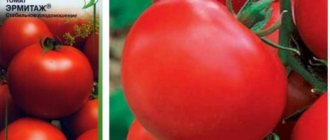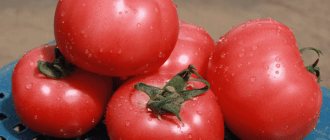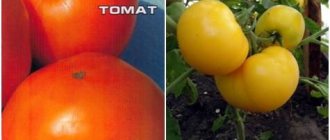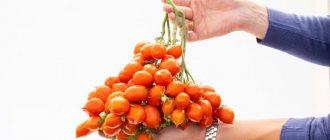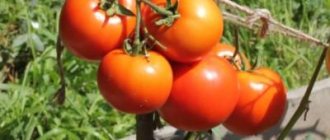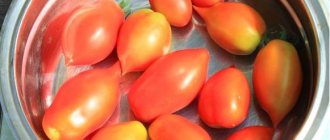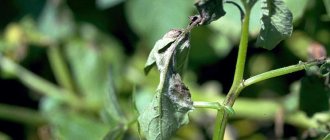The Tomsk hybrid appeared on sale recently and has already proven itself to be tasty and productive. It was bred for regions with harsh climatic conditions, but can be grown in all regions of the Russian Federation.
| Height | Landing location | Ripening time | Fruit color | Fruit size | Origin | Fruit shape |
| Medium height | Open ground | Mid-season | Reds | Large | Hybrid | Flat-round |
Description and characteristics of the variety
Tomato Tomsk F1 is a first generation hybrid, obtained by crossing two varieties. Such plants are particularly resistant to diseases.
Seeds cannot be collected from hybrids, since the new plants will not inherit the characteristics of the parents.
The cultivar was developed by the Dutch company Bejo Zaden BV. It was included in the State Register in 2013 and is recommended for all regions for cultivation in open ground. Produces mid-season salad fruits. From emergence to harvest, 100-115 days pass.
The plant is covered with large dark green leaves. Medium-sized bushes stop growing at a height of 1 m and require staking. The inflorescences are simple, each ripening with 4-5 large, weighty, bright red tomatoes. The average weight of the fruit is 200 g, the maximum is 270 g. They are flat-round in shape, with well-defined ribs. There is no green spot at the base.
The Tomsk hybrid has an excellent taste.
Tomatoes are suitable for preparing salads and processing into thick products. The juice from them will be dense, nutritious and sweet, with a large amount of dry matter.
Agricultural technology
The principles of growing Tomsk f1 tomatoes are similar to other varieties, but do not have certain nuances.
Tomato Persianovsky: characteristics and description of the variety
Seeds of hybrid tomato varieties do not require hardening and disinfection procedures. They already have a very high immunity to diseases of Solanaceous crops and pests.
It would be useful to carry out:
- Sorting. It will allow you to get rid of weak, empty seeds at the initial stage. To do this, you will need a saline solution (take a teaspoon of salt per glass of slightly warm water), into which the seeds are placed for 20 minutes. Poor quality seed will float to the surface, while good seed will remain at the bottom. After the procedure, the seeds should be rinsed with clean water and dried on a paper towel;
- Testing for germination - germinating seeds in damp gauze. To do this, take a plate with low sides, place gauze on it, and soak it with water. Seeds are evenly placed on top of the gauze and covered with a thin layer of cotton wool moistened with water. They should be moistened if necessary, and avoid excessive moisture and drying out.
On a note! The purchased soil mixture does not always turn out to be of high quality: who knows, maybe the manufacturer poured soil into it from a construction site, or it is pure peat. It would be safer to prepare the soil yourself.
The following is added to the soil mixture for planting seedlings:
- Peat. An indispensable component that gives looseness to the soil, absorbs moisture and perfectly retains it;
- Sand or perlite. Be sure to use only coarse, clean river sand. Used as a leavening agent;
- Leaf soil. Gives the soil lightness and looseness;
- Humus. Only well rotted;
- Sawdust is an excellent substitute for peat and sand.
Tomsk seeds are sown in prepared soil in the first half of March, covered with film and removed in a warm place before sprouts appear. After which the film is removed, and the seedlings are placed in a well-lit room. There should be regular watering.
Attention! It is better to use soil from the area where the seedlings will grow - this will speed up the establishment process.
Picking is carried out after the formation of the first 2 leaves. Late picking is possible, after 3-4, but there is a possibility of poor survival of the tomato and its weak immunity.
Forty-day-old seedlings can be planted in open ground, according to the scheme - 40x60 cm.
Note. Seeds begin to germinate at a temperature of +12…+14°C.
The Tomsk tomato loves loose, porous, light, fertile and living soil that can absorb moisture well and retain it, with a normal level of acidity.
Necessary conditions for growing in open ground:
- No more than 2-3 plants per 1 square. m;
- Standardization of flowers;
- Pinching the inflorescences, leaving 4-5 ovaries on them, and preferably 3 - then the fruits will be large and uniform;
- Regular weed removal;
- Stepsonning;
- Removing the lower leaves;
- Regular watering, as the top fertile layer of the soil dries, using only warm, settled barrel water.
Despite good frost resistance, the Tomsk f1 tomato is a heat-loving crop. However, temperatures above +32°C negatively affect the viability of pollen grains and the efficiency of photosynthesis.
The Tomsk tomato variety needs to provide a high level of light so that all stages of vegetative growth occur with maximum efficiency, since the tomato is very light-loving.
Mandatory Garter
Tomsk is a variety of tomatoes that require mandatory tying to a support and pinching.
On a note. It is recommended to form a plant with 2-3 stems when grown in open ground conditions. For a greenhouse, it is better to form a bush with 1-2 stems.
Fertilizing is not a prerequisite for growing tomatoes, and many gardeners ignore it, but it certainly affects the yield of tomatoes. The better you feed the plant, the greater the result will be obtained. You can't overdo it either.
Feeding:
- On the 21st day after planting, the seedlings are fertilized with nitrogenous substances, which promote the growth of greenery. After 3 days, the bushes are watered at the root with a solution of urea (1 tbsp per 10 liters of water);
- When the first flowers appear, the plant is fed with potassium. Chicken manure in the form of a solution is perfect (0.5 liters of manure per bucket of water);
- When flower clusters appear, feed them with potassium humate;
- 14 days after the 3rd feeding, superphosphate is used.
If necessary, fertilizing can be carried out during the period of fruit formation.
Positive qualities of the variety
The Tomsk variety is good in its own way and has the following positive characteristics:
- large size tomatoes (up to 250 g);
- great taste;
- resistance to damage by pests and diseases (for example, fusarium);
- ability to be transported, good keeping quality;
- Possibility of growing both in a greenhouse and in open ground.
Thus, we can conclude that this variety is simply necessary for any personal plot. If you follow all the growing rules, you will certainly reap a wonderful harvest during the season. Seeds of the variety are purchased in the store or via online order.
Recommendations for choosing tomato varieties
When choosing tomato seeds for planting this year, you should never rush - this crop requires care, and it is always a pity when time and effort are wasted.
The first thing you need to start with is a site plan and at least a rough calculation. How much space will be allocated for tomato beds? What varieties do you want to grow this season - yellow, red, pink, green, blue, salad type, for canning or universal, large-fruited, cocktail or cherry? Will these varieties be planted in a greenhouse or in open ground, in what quantity?
Next, you need to soberly assess the situation - how much time are you willing to devote to tomato beds? If it’s not much, you should give preference to determinate varieties that do not require shaping, and reserve only a portion of the tomatoes for a later harvest.
But it is worth considering that determinate tomatoes not only stop growing on their own, but also often have a friendly yield of fruits, rather than extended fruiting.
Finally, it is very important to familiarize yourself with the characteristics of the varieties and hybrids that you like. If you live in a climate zone unfavorable for culture for one reason or another, be sure to take these features into account
Agrotechnical measures
- Watering. Tomato bushes grown from seeds in open ground require less watering, since the more branched root system draws moisture from the lower layers of the soil. Additional watering is required during prolonged periods of drought.
- Feeding. If the seeds are planted in well-fertilized soil, the first fertilizing can be done after the third leaf appears on the sprouts. The second - during the period of fruit set. Superphosphates or organic matter are used as fertilizers.
- Bush care. Tomato bushes of the Obereg variety do not require high garters or pinching, but it is recommended to tear off the lower leaves to give more freedom for the development of the upper fruit-bearing branches. For bushes with abundant clusters of ovaries, a little support may be needed to prevent heavy fruits from breaking off fragile branches.
- During the entire growth period, weeding and fluffing of the soil are carried out.
- Diseases and pests. The variety is protected from major tomato diseases. To combat insect pests, special means or folk recipes are used.
Fruit characteristics
The fruits of tomatoes of the Tomsk F1 variety are quite large in size. The average weight of the fetus reaches 250 grams. The shape of the fruit is flat-round. Externally they are smooth, shiny and dense. The color is rich red. Tomatoes are distinguished by high taste and pleasant aroma. The fruit is juicy and moderately fleshy, with a light and pleasant sourness. The fruit contains a large amount of sugars.
See also
Description of the Ashdod tomato variety and its characteristicsRead
This variety of tomato is suitable for preparing salads, other various dishes, and for canning. They are also suitable for preparing tomato juices, ketchups, and tomato paste. Freshly picked tomatoes are ideal for eating in their pure form.
Healthy! After harvesting, the fruits are stored for up to 15 days without losing their taste. They also tolerate transportation well, remaining dense.
Advantages and disadvantages
Tomsk f1, like any other tomato variety, has its pros and cons.
Positive features of this variety:
- Excellent taste characteristics;
- Large fruit sizes;
- High resistance to pests and diseases;
- Easy to grow;
- Keeping quality for a long time without loss of taste and external qualities;
- Possibility of growing in a greenhouse and exhaust gas;
- Adaptation to harsh weather conditions;
- A very large amount of useful substances in the fruit.
Disadvantage - collected seeds from grown tomatoes will not give a good harvest, since it is a hybrid.
On a note. Many summer residents note that the Tomsk tomato variety has amazing resistance to various diseases and pests. You don’t have to spray it with chemicals several times a season.
The tomato is definitely interesting, and it’s definitely worth trying to grow it on your own plot. The only thing is that the seeds are not so easy to find. But for those who are really interested in it, this will not be a significant obstacle.
- Author: Maria Sukhorukikh
Rate this article:
- 5
- 4
- 3
- 2
- 1
(1 vote, average: 5 out of 5)
Share with your friends!
How are tomatoes grown?
It is important to understand that the Tomsk F1 variety is a hybrid. This means that collecting seeds from it is pointless - the harvest grown with their help will be meager.
These tomatoes are grown both in greenhouses and in open ground. Despite its small height, the bush itself is quite powerful, so it needs support. When planted in open ground, the variety gives the best results when formed into 2-3 stems and tied to a support. In film shelters it is better to form the bush into 1-2 stems.
Read also: How balusters are attached to steps
It belongs to heat-loving crops. Seeds begin to germinate at a constant air temperature within +12...+14°C. At a temperature of +10°C, seed germination is no more than 10%, while the vegetative growth of the plant stops. At an average temperature of +15°C and above, the seedling does not bloom. If the temperature drops to 0°C even for a short period, the tomato will die.
If possible, the hybrid should also be protected from high temperatures; when the mark passes +32°C, the pollen grains of the plant become unviable, and the efficiency of photosynthesis decreases.
To effectively go through all stages of growth, this crop requires a high level of illumination. The more light, the sooner the plant will enter the fruiting phase.
Despite the demands on lighting, the tomato easily tolerates a lack of moisture.
Dry air will even be beneficial for him. With this indicator of 45-60%, pollen is well separated from the anthers, which has a positive effect on the pollination process. The tomato can cope with soil with a relative lack of nutrients and low acidity due to the presence of a strong root system.
However, these factors should be avoided during the fertile period. When the maximum field moisture capacity of the soil decreases below 70%, additional watering is recommended. At the beginning of the growing season, experts advise feeding the plant with fertilizers with a phosphorus-potassium composition, removing weeds and loosening the soil. Timely vibrating of flowering clusters will help increase the fruitfulness of tomatoes.
After picking, the fruits are stored well, without losing their taste for up to two weeks. Tomatoes tolerate transportation well, maintaining a presentable appearance.
Tomsk F1 tomatoes simply need to be planted on your site. If you follow all the care recommendations, you will certainly get a wonderful harvest. And reviews from vegetable growers leave no doubt about this.
